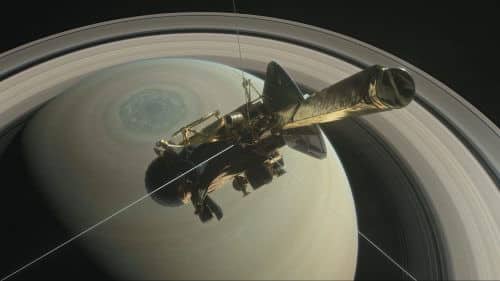In 3 days, on September 15th, the Cassini spacecraft will complete its 13-year exploration of Saturn in a fitting grand finale. Cassini became the first spacecraft to enter orbit around Saturn in 2004, and since then has studied the planet and its moons, taken breathtaking pictures of it and made amazing discoveries about it, which provided a basis for scientific articles and theories.
Credit: Israel Space Agency

Preparations for parting
As part of its mission, Cassini passed as many times as possible near Saturn and Titan in order to examine whether there are seasonal changes in them. This mission was also designed to use up as much of its fuel reserve as possible before the planned crash.
Cassini's mission has already been extended twice in the past, but now, with the fuel reserves running low, NASA has made a decision to blow it up on Saturn, fearing that its landing on one of its moons, such as Titan or Enceladus where there is a chance for life forms to develop, could lead to their contamination.
In April 2017 Cassini cracked a series of 22 orbits between the star and its rings that also revealed new discoveries of Saturn and its inner rings as never seen before. Each week such a Cassini covered 2,000 kilometers between Saturn and its rings in a journey that no other spacecraft had made.
On September 14, as part of its farewell mission, Cassini will send back to Earth the last images of its great discoveries - Saturn's innermost rings, the moon Titan and its lakes, the hexagonal stream at Saturn's north pole. Its greater proximity than ever before could provide new information about Saturn's gravity and magnetic field, the speed of its rotation around its axis, the materials Saturn's rings are made of, and so on. After sending the images to the NASA laboratories located about 1.4 billion kilometers away in California, it will shut down its camera forever.
Cassini's farewell mission yielded a series of amazing discoveries that gave her a wonderful swan song after 13 years of research, amazing photographs and wonderful discoveries and she may continue to inspire amazement until the end.
Cassini's last moments

On September 15, Cassini will dive at a speed of 1,400 km/h into Saturn's atmosphere. Since the upper atmosphere on Saturn is composed of hydrogen, the combination of the forces of the fall and the gas will cause the spacecraft's fuel tanks to ignite, but since there is no oxygen on the surface of the planet, the spacecraft will not turn into a fireball but will explode in a bright explosion as white plasma and a tremendous heat of about 5,500 degrees, in about 4 minutes from its entry into Saturn's atmosphere.
Even in its last moments, Cassini will continue to enrich scientific knowledge. As long as she can, she will transmit data to scientists and the knowledge gathered from her in the moments of the crash will provide the last information about Saturn's atmosphere and its composition, until communication with Cassini is lost forever.
Want to know more about Cassini's wonderful journey in space? Enter the Israel Space Agency website
See more on the subject on the science website:

2 תגובות
sad